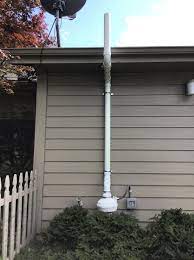When purchasing a house, all buyers want to know that their new home will be a safe environment to live in. Some things are easy to see from a simple inspection. A roof that leaks, a cracked foundation, or a loose railing can all be seen with the naked eye and fixed to give you peace of mind that all is well.
a house, all buyers want to know that their new home will be a safe environment to live in. Some things are easy to see from a simple inspection. A roof that leaks, a cracked foundation, or a loose railing can all be seen with the naked eye and fixed to give you peace of mind that all is well.
Some hazards, however, are not so easily recognized, but can be just as dangerous. This article is about radon, the risks associated with it, and what to do when your home has unsafe radon levels.
Radon is a radioactive gas that comes from the natural breakdown of uranium in soil, rock and water, It is odorless and colorless, but it can be measured by a detector. Radon can cause lung cancer and other health problems. In fact, it is the #2 cause of lung cancer in the United States. Radon is found in all 50 states and in every Canadian province.
Radon can enter your home through cracks in the foundation or flooring. It also can make it’s way up through the sump crock found in many homes. Testing for Radon is a simple, inexpensive way to find out if you have a radon problem in your home. There are several types of radon testing.
Passive monitors can be purchased at most hardware stores and are relatively inexpensive. The average kit will cost between $20 and $50. After being placed in the measurement area for the recommended period of time (from 2 to 90 days), the kit is sent to a laboratory for evaluation. This kind of test is easy and cheap for a homeowner to perform, but the time needed for testing and the subsequent waiting for lab results make it unsuitable for testing as part of most real estate transactions. Active device testing is more commonly used when there is a radon testing contingency in an offer to purchase, because after the testing period (usually 48 to 72 hours) the device will provide an instant report of the radon levels in the tested area.
The US Environmental Protection Agency has set an action level for radon mitigation (correction) of 4.0 pCi/L. The standard Wisconsin Offer to Purchase documents include the option for a Radon Contingency. Here is the specific language:
“This offer is contingent upon Buyer obtaining a current written report of the results of a radon test at the Property performed by a qualified third party in a manner consistent with applicable (EPA) and Wisconsin Department of Health Services (DHS) protocols and standards indica
ting an EPA average radon level of less than 4.0 picoCuries per liter (pCi/L), at (Buyer’s)(Sellers) expense.”
The language does on to say that the contingency will be satisfied unless the buyer provides the seller with a report showing that the radon level is higher than 4.0 before the contingency deadline is passed.
If the radon levels in a home are measured above the EPA action level, remediation is required to make the home safe from the health risks associated with radon exposure. Installation of a radon mitigation system generally costs between $1,000 and $2,000, depending upon the extent of the problem and various issues pertaining to the construction and design of the home. Remediation will usually include sealing of any significant cracks in the basement floor, covering and sealing of any sump crocks, and installation of a ventilation system which draws air from a sump crock (if present) or through a small hole drilled into the basement floor, and expels the toxic gas out of the house and up above the roof line.
When writing an offer to purchase, a buyer including a radon testing contingency will have the option of providing the seller with the Right to Cure. This means that if the radon level is too high, the seller has the automatic option to remediate the problem to keep the transaction together, and the buyer would not have the right to terminate the transaction on the basis of high radon levels. You can read more about the Right to Cure HERE on one of our other blog posts.
As Realtors in Wisconsin we often say that everyone should test their home for radon, but that not every transaction should be dependent upon the results of the test. Although the risks of radon exposure are significant, the cost of mitigation are relatively low when compared to some other home repairs. When writing an offer in competition with other buyers, or when other terms in an offer are less appealing (like a lower purchase price for example), waiving the radon testing contingency may be a necessary compromise to get an offer accepted by the seller. A good Realtor can offer expert advice on whether a radon testing contingency will impact your offer’s chances of being accepted.
Do you have any questions about radon or radon mitigation that we can help you with? We’d love to hear from you!
Click HERE to watch our interview with Brian Thompson of Lifetime Radon Solutions.


 Facebook
Facebook
 X
X
 Pinterest
Pinterest
 Copy Link
Copy Link